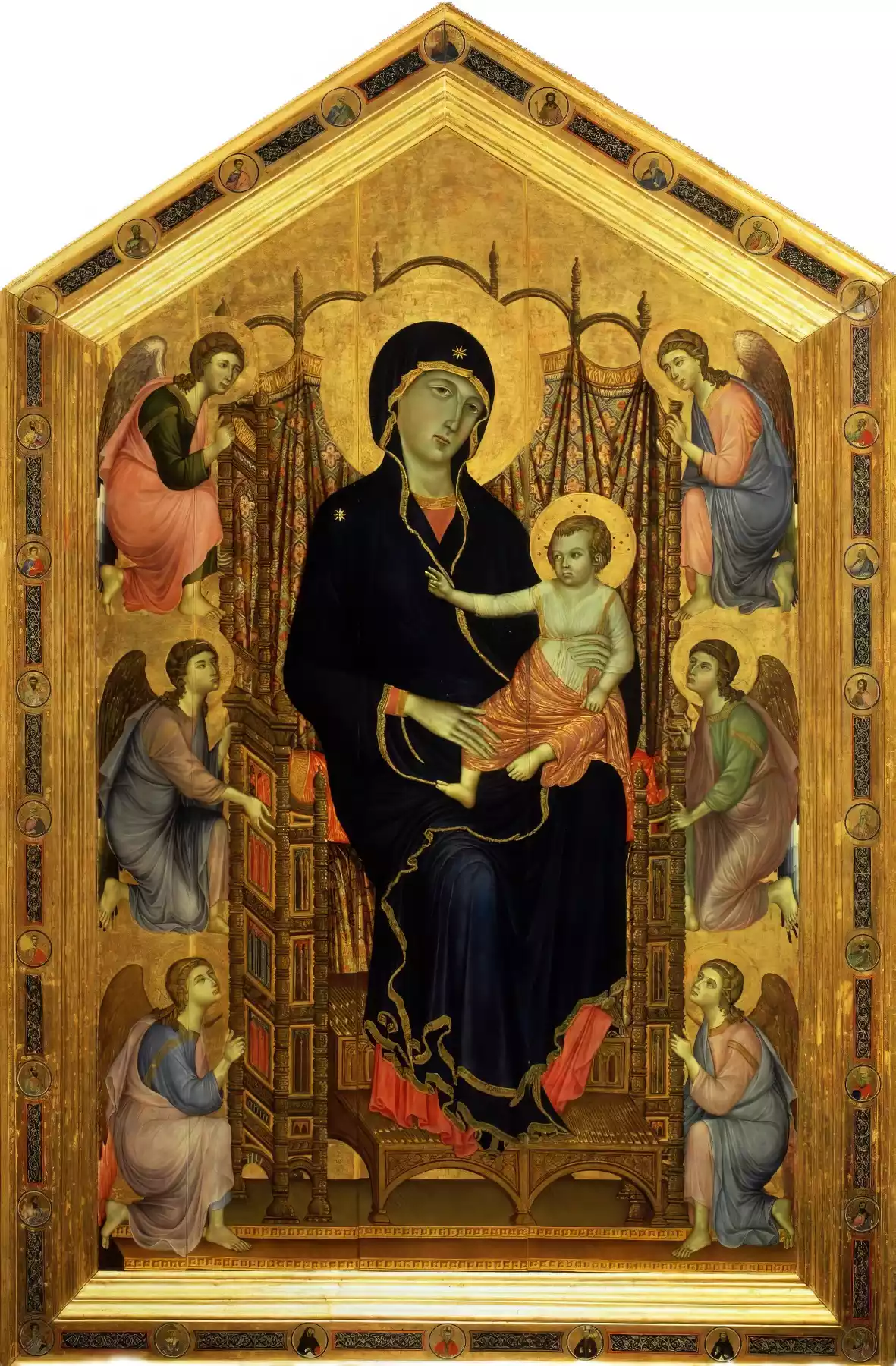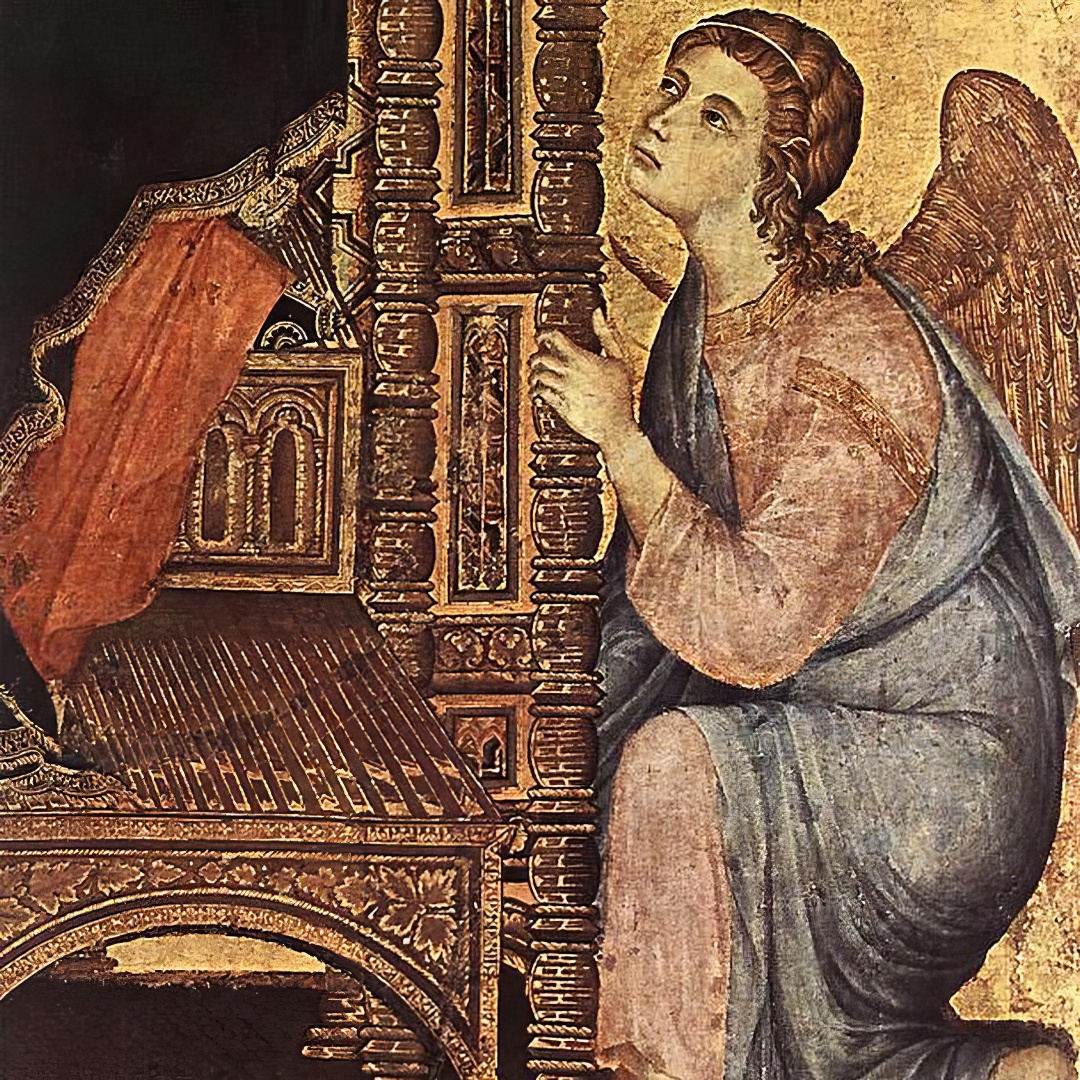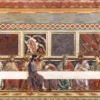
The Rucellai Madonna (1285) by Duccio di Buoninsegna is a landmark of medieval art, combining Byzantine influences with innovative elements that herald the Renaissance.
Title: Maestà (Rucellai Madonna)
Artist: Duccio di Buoninsegna
Type: Portable icon, Religious work
Date: 1285
Dimensions: 450 cm × 290 cm
Materials: Egg tempera on wood
Location: Uffizi Gallery, Florence, Italy
The Rucellai Madonna is one of the most significant works of medieval art and marks a critical turning point in the evolution of Italian painting. Created in 1285 by Duccio di Buoninsegna for the Brotherhood of the Compagnia dei Laudesi, this image signifies the transition from the Byzantine tradition to the emerging Sienese style. For centuries, the work was incorrectly attributed to Cimabue, with Giorgio Vasari supporting this view until the early 20th century. Its name comes from the Rucellai chapel of Santa Maria Novella in Florence, where it remained from 1591 to 1937, before being transferred to the Uffizi Gallery. The imposing composition, with the Virgin and Child surrounded by six angels, reveals the Byzantine influences in the composition, while simultaneously introducing innovative elements that herald the Renaissance. The gold background, the bold outlines, and the standardized depiction of the figures coexist with a new sense of depth and human expression, creating a work that bridges two eras of art.

The ornate throne in the Rucellai Madonna with Gothic architectural elements creates a sense of three-dimensional space, an innovation by Duccio for his time.
The Historical Significance of the Rucellai Madonna
The Commission and Historical Context
The commission of the Rucellai Madonna in 1285 by the Brotherhood of the Compagnia dei Laudesi represents a pivotal moment in the history of Italian art. Siena during this period was experiencing a spiritual and artistic flourishing, competing with Florence. Duccio, as revealed in a historical study, was known for his refusal to participate in a citizen militia formed for battle in Maremma, as well as for his absence from assemblies – elements that reveal his independent personality (Emmerson).
The work was created during a time of intense socio-political upheaval and religious searching in central Italy. The commission of such a large and ambitious work reflects the importance of religious brotherhoods in the spiritual and social life of the Italian city-states of the 13th century. (Search for more information with the word: Medieval Siena Art)
From Cimabue to Duccio: The Attribution Controversy
For centuries, the Rucellai Madonna was attributed to Cimabue, with Vasari reinforcing this view. The revelation of the true identity of the creator in the early 20th century reshaped the understanding of the evolution of Italian painting. The shift of attribution from the Florentine Cimabue to the Sienese Duccio highlighted the significance of Sienese painting in shaping the early Renaissance (Hyman).
The scientific analysis of the technical characteristics of the work revealed Duccio’s unique artistic handwriting: subtle color tones, intricate details, and a more emotional approach to the depiction of sacred figures – elements that differentiate from Cimabue’s style.
The Position of the Rucellai Madonna in Sienese Painting
The work marks the beginning of the golden age of Sienese painting and establishes Duccio as the father of this school. The Rucellai Madonna masterfully combines Byzantine style with innovative elements that herald the Italian Renaissance: the careful gradation of light, the graceful movement of the figures, and the delicate rendering of emotions.
The influence of the work is evident in later Sienese artists such as Simone Martini and Pietro Lorenzetti, who further developed Duccio’s innovative elements, establishing a distinct artistic tradition parallel to that of Florence.
The Journey of the Work to the Uffizi Gallery
The journey of the Rucellai Madonna from its original placement in the church of Santa Maria Novella to its final residence in the Uffizi Gallery reflects the changing perceptions of religious art and the preservation of cultural heritage. The sacred work was moved to various locations within the church before finally being installed in the Rucellai chapel in 1591, from which it took its name (Hulbert).
Its transfer to the Uffizi in 1937 for an exhibition dedicated to Giotto sealed its recognition as one of the greatest works of art of the Italian medieval period and ensured its protection and study under optimal conditions.

The six angels surrounding the throne in the Rucellai Madonna reveal Duccio’s effort to individualize the figures with distinct poses and expressions.
Analysis of Iconography and Technique
The Composition and Byzantine Influences
The Rucellai Madonna by Duccio is a monumental composition that draws from the Byzantine tradition while simultaneously renewing it. The central arrangement with the Virgin on a throne, surrounded by angels, follows the Byzantine model of the Nikopoia, but the rendering of the figures is more human and emotional. The gold background, a legacy of Byzantine art, serves as a symbol of heavenly light and divine presence, while also enhancing the sense of grandeur that the sacred work exudes (Wetterbergh).
The architecture of the throne, with its intricate Gothic elements, adds depth to the composition and reflects the artistic trends of the time. Upon careful observation of the image, we discern how Duccio manages to create a sense of three-dimensional space while maintaining the frontal orientation and solemnity required by the subject. (Search for more information with the word: Byzantine influence Italian painting)
The Depiction of the Virgin: Mater Dei
At the center of the composition stands the figure of the Virgin as Mater Dei (Mother of God), one of the most important and symbolic representations in Christian art. The rendering of her face, with the slight tilt of the head and melancholic expression, conveys a restrained sorrow that foreshadows the Passion of Christ. This emotional dimension is an innovation of Duccio and moves away from the strict standardization of Byzantine models.
The deep blue of her mantle, adorned with golden details and stars, symbolizes both her royal status and her heavenly origin. The delicacy with which Duccio renders the folds of the fabric reveals the underlying volume of the body, imparting naturalness and presence.
The Angels: Symbolism and Rendering
The six angels surrounding the throne of the Virgin are a key element of the iconography of the Rucellai Madonna and contribute to the sense of hierarchy and order. Each angel has a distinct pose and expression, reflecting Duccio’s effort to individualize the figures, moving away from Byzantine standardization.
Particular attention has been given to the rendering of the angels’ wings and garments, with rich folds and subtle colorings creating a sense of movement and liveliness. The interplay of colors in their garments creates a visual rhythm that enhances the coherence of the composition.
The Christ Child: Symbolic Representation
The Christ Child, seated in his Mother’s arms, is depicted with features that suggest his divine nature. His mature expression and body posture confer royal grandeur, while the gesture of blessing emphasizes his salvific role. His orange-gold garment, with intricate folds and bright highlights, reflects the divine light emanating from his figure.
The relationship between Mother and Child is rendered with exceptional delicacy, as the tender contact of their hands and the interaction of their gazes reveal both the human and divine dimensions of this relationship.
Duccio’s Technique: Color, Gold, and Light
Duccio’s technical mastery is revealed in the skill with which he handles color and light in the Rucellai Madonna. The egg tempera, applied in thin, transparent layers, allows for the achievement of extremely soft transitions and subtle shades. The bright highlights on the faces and fabrics create the impression that the figures are illuminated by an inner, spiritual light.
Gold is used not only for the background but also for the intricate details in the garments, the halo, and the decorative elements of the throne, creating a dazzling visual experience that evokes the splendor of the heavenly realm. This technical approach marks the transition from the strictness of Byzantine art to the more emotional and human-centered art of the early Renaissance.

The Christ Child in the Rucellai Madonna is depicted with features that suggest his divine nature and salvific role.
Conclusion
The Rucellai Madonna by Duccio di Buoninsegna stands as a landmark work that bridges two worlds: the Byzantine tradition and the emerging aesthetic of the Renaissance. Through his exceptional technique and sensitive artistic perception, Duccio managed to create an image that transcends strict religious boundaries and touches human emotion. The delicate balance between spirituality and humanity, grandeur and intimacy, tradition and innovation makes this work timeless and always relevant. Its influence on the evolution of Sienese painting and more broadly on Italian art is a testament to the profound artistic insight of its creator and his ability to transform tradition into something new, vibrant, and moving.

The melancholic expression of the Virgin in the Rucellai Madonna is one of Duccio’s innovations, providing emotional depth beyond standardization.
Frequently Asked Questions
Why is Duccio’s Madonna called “Rucellai”?
The name “Rucellai Madonna” comes from the Rucellai chapel of the church of Santa Maria Novella in Florence, where the work was housed from 1591 to 1937. The Rucellai family was an important Florentine family that funded many artistic works. Although they were not the original commissioners of the image, their name became associated with Duccio’s masterpiece due to its long stay in the chapel of the same name.
What innovative elements did Duccio introduce in the Rucellai Madonna?
Duccio introduced several innovative elements that differentiated his work from the strict Byzantine tradition. In the Rucellai Madonna, we observe a more natural and emotional rendering of the faces, subtler color transitions, and an increased sense of depth and volume. The folds of the garments reveal the body underneath, while the individualized poses and expressions of the angels add liveliness and variety to the composition.
How did Duccio’s Rucellai Madonna influence later art?
The impact of Duccio’s image was pivotal for the evolution of Sienese painting and more broadly for Italian art. The emotional immediacy and elegant rendering of the figures influenced artists such as Simone Martini and the Lorenzetti brothers. His approach to color, light, and expression opened new avenues for depicting sacred themes in a more human way, heralding aesthetic values that would fully blossom during the Renaissance.
What is the relationship of the Rucellai Madonna with Byzantine art?
The Rucellai Madonna retains key elements of the Byzantine tradition, such as the gold background, the frontal depiction of the Virgin, and the hierarchical arrangement of the figures. However, Duccio transforms these elements by introducing greater naturalness and emotional expressiveness. This relationship with Byzantine art is particularly significant as it reflects the cultural exchange between East and West and the gradual transition to new aesthetic perceptions.
What is the significance of the technical details in Duccio’s Madonna image?
The technical details in the Rucellai Madonna reveal Duccio’s exceptional craftsmanship and contribute to the overall aesthetic and symbolic dimension of the work. The detailed rendering of the intricate fabrics, the architectural elements of the throne, and the golden decorative motifs are not merely decorative but enhance the theological significance of the work. Particularly important is the treatment of light on the faces and bodies, which imparts liveliness and spirituality to the figures.
Bibliography
- Emmerson, Richard K. Key Figures in Medieval Europe: An Encyclopedia. London: Routledge, 2013.
- Hulbert, Charles Augustus. Theotokos: or The mother of our Lord, a sermon. To which is added, an appendix on the following subjects: I. The practice and opinions of the Jews, respecting Mary, before the Birth of Christ. II. The practice and opinions of the primitive Christians, respecting the Virgin. London: J. G. & F. Rivington, 1842.
- Hyman, Timothy. Sienese Painting. London: Thames & Hudson, 2022.
- Wetterbergh, Carl Anton. Das Altargemälde: Ein Genrebild. Berlin: Duncker, 1850.

